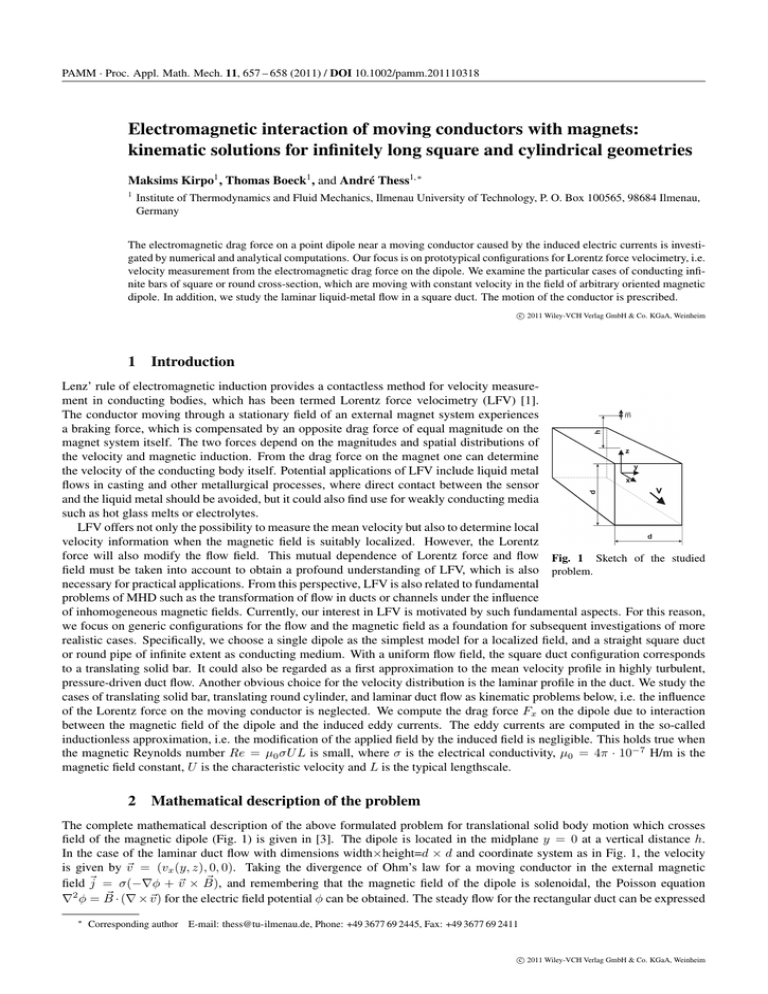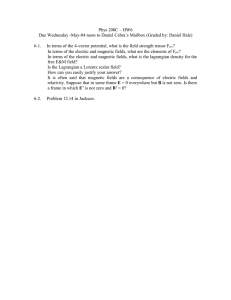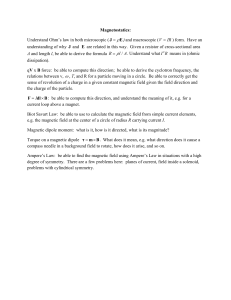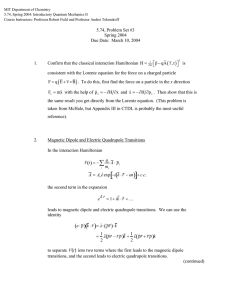Electromagnetic interaction of moving conductors with magnets
advertisement

PAMM · Proc. Appl. Math. Mech. 11, 657 – 658 (2011) / DOI 10.1002/pamm.201110318 Electromagnetic interaction of moving conductors with magnets: kinematic solutions for infinitely long square and cylindrical geometries Maksims Kirpo1 , Thomas Boeck1 , and André Thess1,∗ 1 Institute of Thermodynamics and Fluid Mechanics, Ilmenau University of Technology, P. O. Box 100565, 98684 Ilmenau, Germany The electromagnetic drag force on a point dipole near a moving conductor caused by the induced electric currents is investigated by numerical and analytical computations. Our focus is on prototypical configurations for Lorentz force velocimetry, i.e. velocity measurement from the electromagnetic drag force on the dipole. We examine the particular cases of conducting infinite bars of square or round cross-section, which are moving with constant velocity in the field of arbitrary oriented magnetic dipole. In addition, we study the laminar liquid-metal flow in a square duct. The motion of the conductor is prescribed. c 2011 Wiley-VCH Verlag GmbH & Co. KGaA, Weinheim 1 Introduction Lenz’ rule of electromagnetic induction provides a contactless method for velocity measurement in conducting bodies, which has been termed Lorentz force velocimetry (LFV) [1]. The conductor moving through a stationary field of an external magnet system experiences a braking force, which is compensated by an opposite drag force of equal magnitude on the magnet system itself. The two forces depend on the magnitudes and spatial distributions of the velocity and magnetic induction. From the drag force on the magnet one can determine the velocity of the conducting body itself. Potential applications of LFV include liquid metal flows in casting and other metallurgical processes, where direct contact between the sensor and the liquid metal should be avoided, but it could also find use for weakly conducting media such as hot glass melts or electrolytes. LFV offers not only the possibility to measure the mean velocity but also to determine local velocity information when the magnetic field is suitably localized. However, the Lorentz force will also modify the flow field. This mutual dependence of Lorentz force and flow Fig. 1 Sketch of the studied field must be taken into account to obtain a profound understanding of LFV, which is also problem. necessary for practical applications. From this perspective, LFV is also related to fundamental problems of MHD such as the transformation of flow in ducts or channels under the influence of inhomogeneous magnetic fields. Currently, our interest in LFV is motivated by such fundamental aspects. For this reason, we focus on generic configurations for the flow and the magnetic field as a foundation for subsequent investigations of more realistic cases. Specifically, we choose a single dipole as the simplest model for a localized field, and a straight square duct or round pipe of infinite extent as conducting medium. With a uniform flow field, the square duct configuration corresponds to a translating solid bar. It could also be regarded as a first approximation to the mean velocity profile in highly turbulent, pressure-driven duct flow. Another obvious choice for the velocity distribution is the laminar profile in the duct. We study the cases of translating solid bar, translating round cylinder, and laminar duct flow as kinematic problems below, i.e. the influence of the Lorentz force on the moving conductor is neglected. We compute the drag force Fx on the dipole due to interaction between the magnetic field of the dipole and the induced eddy currents. The eddy currents are computed in the so-called inductionless approximation, i.e. the modification of the applied field by the induced field is negligible. This holds true when the magnetic Reynolds number Re = µ0 σU L is small, where σ is the electrical conductivity, µ0 = 4π · 10−7 H/m is the magnetic field constant, U is the characteristic velocity and L is the typical lengthscale. 2 Mathematical description of the problem The complete mathematical description of the above formulated problem for translational solid body motion which crosses field of the magnetic dipole (Fig. 1) is given in [3]. The dipole is located in the midplane y = 0 at a vertical distance h. In the case of the laminar duct flow with dimensions width×height=d × d and coordinate system as in Fig. 1, the velocity is given by ~v = (vx (y, z), 0, 0). Taking the divergence of Ohm’s law for a moving conductor in the external magnetic ~ and remembering that the magnetic field of the dipole is solenoidal, the Poisson equation field ~j = σ(−∇φ + ~v × B), 2 ~ ∇ φ = B · (∇ ×~v ) for the electric field potential φ can be obtained. The steady flow for the rectangular duct can be expressed ∗ Corresponding author E-mail: thess@tu-ilmenau.de, Phone: +49 3677 69 2445, Fax: +49 3677 69 2411 c 2011 Wiley-VCH Verlag GmbH & Co. KGaA, Weinheim 658 Section 13: Flow control Fig. 2 Non-dimensional force Fx acting on the z aligned magnetic dipole located at x = 0, y = 0 for different h from solid conducting bars with square or round cross-sections. Fig. 3 Non-dimensional force Fx acting on the z aligned magnetic dipole located at x = 0, y = 0 for different h from solid conducting bar with square cross-section or laminar duct. in a form of expansion series and normalized by the average velocity v̄.The induced currents have no normal component on all surfaces of the duct. Since the flow field satisfies the no-slip condition, this results in homogenous Neumann boundary conditions ∂φ/∂z = 0 at z = 0, z = −d and ∂φ/∂y = 0 at z = ±d/2. The currents and potential should also vanish at x = ±∞.The Laplace or Poisson equation problems for φ with appropriate boundary conditions BC could not be solved analytically. An automated MatlabTM script coupled with ComsolTM solver was used to obtain the electric potential, the induced currents, and the braking force numerically. 3 Results and discussion All the numerical results here use non-dimensional units based on the characteristic length L0 = d, characteristic velocity equal to the conductor average velocity V0 = v̄ and the characteristic magnetic field intensity B0 = µ0 md−3 , where m is the magnetic moment. This choice of the characteristic parameters leads to the following expression for the Lorentz force F~ = σvµ20 m2 d−3 F~ ∗ . The “star” symbol, which represents non-dimensional quantities, is omitted on all charts. Our computations show that the Lorentz force dependence on distance h can be expressed by different power laws for small and large h (Fig. 2 and 3). This dependence is Fx ∼ 1/h3 at small h for translational motion of solid bodies in agreement with the results for a translating infinite plate developed in [2]. For a round cylinder with radius R and d2 = πR2 , i.e. identical cross-section, one finds slightly smaller Lorentz force values compared to the square cross-section at larger distances, but the force obeys the same power laws for h → 0 and h → ∞ (Fig. 2). The Lorentz force computed for the laminar flow in the duct shows smaller growth for small h values (Fig. 3) which caused by the no-slip condition leading to a lower effective velocity in the region of strong magnetic field near the duct walls. The exponent -7 for h 1 is not immediately obvious in the framework of the electric potential formulation. One can demonstrate this result using a series expansion in the small parameter ε = 1/h, which accounts for the slow variation in the magnetic field along the bar. This approach is described in detail in [3] and leads to the following expression for the main component of the Lorentz force for square cross-section: Fx = −15 45.561kx2 + 8ky2 + 71.785kz2 /216 πh7 . The unit vector ~k = (kx , ky , kz ) denotes the orientation of the magnetic dipole. The formula clearly shows that the magnetic dipole with the orientation vector ~k = (0, 0, 1) provides the largest value of Fx . Comparison of the numerical results with the obtained asymptotic expression shows roughly 2% discrepancy. The present work will be continued with a more detailed analysis of the kinematic problem for the round cylinder including laminar flow. Acknowledgements We are grateful to our colleagues S. Tympel and D. Krasnov for interesting discussions and to the DFG for financial support (Research Training Group “Lorentz Force Velocimetry and Lorentz Force Eddy Current Testing”, grant GRK 1567/1). References [1] A. Thess, E. Votyakov, and Y. Kolesnikov, Lorentz Force Velocimetry, Phys. Rev. Lett. 96, 164501 (2006). [2] A. Thess, E. Votyakov, B. Knaepen, and O. Zikanov, Theory of the Lorentz force flowmeter. New J. of Phys. 9, 299 (2007). [3] M. Kirpo, S. Tympel, T. Boeck, D. Krasnov, and A. Thess, Electromagnetic Drag on a Magnetic Dipole Near a Translating Conducting Bar. J. Appl. Phys. accepted (2011); doi:10.1063/1.3587182 c 2011 Wiley-VCH Verlag GmbH & Co. KGaA, Weinheim www.gamm-proceedings.com




